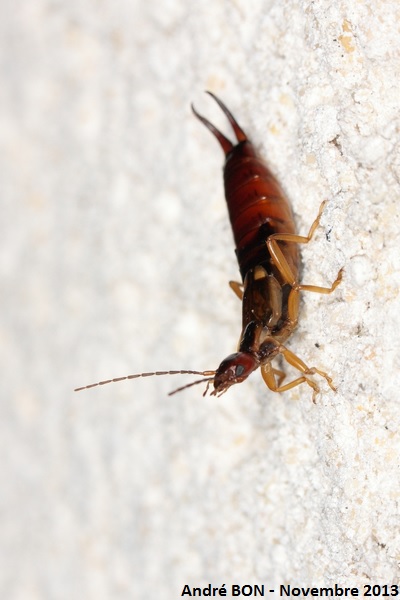
| Common Earwig (Forficula auricularia (Linnaeus, 1758)) |

|
|
Scientific name: Forficula auricularia (Linnaeus, 1758) Common name: Common Earwig Other names: European Earwig French name: Forficule des jardins, Pince-oreille commun, Perce-oreille commun. Order: Dermaptera Family: Forficulidae Wingspan : Total size: 14 to 21 mm for males, including 4 to 9 mm for the cerci; 12.5 to 17.5 mm for females, including 3 to 4.5 mm for the cerci. Biotope: In the litter, under tree barks, under stones, in rock crevices, on plants and flowers. Geographic area: Originated from the Palaearctic region, Common Earwigs have been introduced to North America in the early twentieth century. They have been also introduced to Australia and New Zeeland. Observation period : Adults of the new generation are observed in summer about in August. Males do not overwinter. The first nymphs appear late winter. There may be a second hatch whose nymphs appear early summer. Females of previous year survive till July. They take care of their offspring. |
Earwigs are insects with an elongated body ending with two forceps-like cerci. There are about twenty species in France. The Common Earwig has a shiny yellowish brown to blackish brown body. The long antennae show 14 articles. The membranous wings, which are folded as a N, slightly protrude at the back of the very short yellowish brown elytra. The legs are yellow with slightly swollen femurs. Males' cerci are strongly curved and toothed on the inner side next to the base. Females' cerci are straighter. Common Earwigs are active during the night. They feed on petals and young shoots on shrubs and flowers. They can also feed on aphids and other small insects. Among the other species found in France and showing membranous wings protruding at the back of the elytra, Nala lividipes and Labia minor are a shorter body size, less than 10 mm. Labidura riparia is a larger species but showing antennae with more than 25 articles. Anechura bipunctata is a very dark species which can be identified by two pale spots on the elytra. |
| [To know more about the Common Earwig] [Top] |

|
The size of the insect, the overall colour, the number of articles of the antennae and the membranous wings slightly exceeding the elytra confirm the identification of the Common Earwig species. The almost straight cerci indicate one female. |